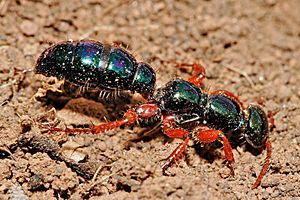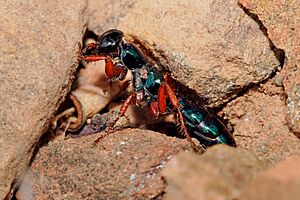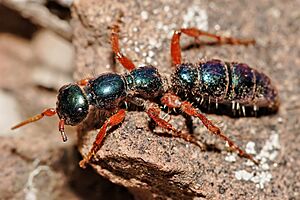Blue ant facts for kids
Quick facts for kids Blue ant |
|
|---|---|
 |
|
| Female | |
| Scientific classification |
The blue ant (Diamma bicolor) might sound like an ant, but it's actually a type of large, shiny wasp! It's also known as the blue-ant or bluebottle. This amazing insect lives in parts of southern and southeastern Australia, including Tasmania, New South Wales, Victoria, and South Australia. It's quite special because it's the only member of its group, called Diamma.
Contents
About the Blue Ant
Blue ants are not true ants. They are a kind of wasp that lives alone, not in a colony. These wasps are sometimes called flower wasps. They are also known as "parasitic" wasps. This means their young grow by feeding on other insects.
What Does It Look Like?
Blue ants have a very striking look. Their bodies are a bright, metallic blue-green color. Their legs are a contrasting red.
Female blue ants are larger than males. They can grow up to about 25 millimeters (1 inch) long. Females do not have wings and live on the ground.
Male blue ants are smaller, usually around 15 millimeters (about 0.6 inches) long. Unlike the females, males have wings.
Where Does It Live?
This unique wasp is native to southern and southeastern Australia. You can find it in states like Tasmania, New South Wales, Victoria, and South Australia.
What Do They Do?
Female blue ants are special hunters. They only hunt mole crickets. Other wasps in their family usually attack beetle larvae.
When a female blue ant finds a mole cricket, she uses her stinger to inject venom. This venom makes the cricket unable to move. The female then lays an egg on the cricket. This way, when the wasp larva hatches, it has a fresh supply of food ready to eat.
Adult blue ants, both male and female, drink nectar from flowers. As they feed, they help to pollinate different native Australian flowers. This helps the plants make seeds.
Is Its Sting Dangerous?
Yes, the sting of a blue ant can be painful for humans. It can cause a strong burning feeling and swelling. In very rare cases, some people might have a serious allergic reaction, like anaphylaxis. If someone has a severe reaction, they need medical help right away.
See also
 In Spanish: Hormiga azul para niños
In Spanish: Hormiga azul para niños



